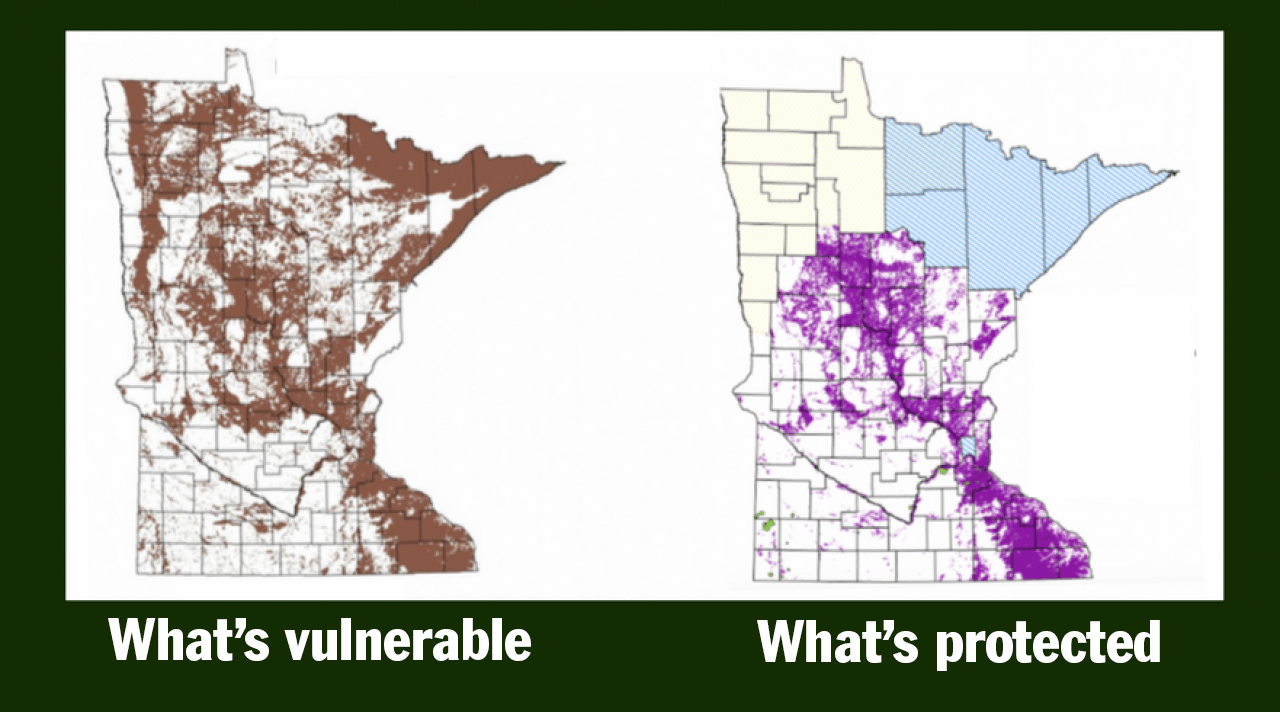State’s Groundwater Protection Rule now in full effect
As noted in a recent MPR News story, Minnesota farm operators will no longer be allowed to apply nitrogen fertilizer in the fall or on frozen ground in parts of Minnesota where the groundwater is vulnerable to contamination.
The new requirements, which apply to about 12.6% of Minnesota’s cropland, are part of the state’s groundbreaking Groundwater Protection Rule.
Protecting our drinking water
The long-awaited Groundwater Protection Rule aims to protect public health and drinking water supplies by addressing nitrate fertilizer contamination in Minnesota’s groundwater.
About 75% of Minnesotans get their drinking water from public and private wells. Many of these wells are susceptible to nitrate contamination from cropland fertilizers, which can make the water unsafe to drink.
It’s no small problem to solve. Today, at least 537 public water supply wells across the state have elevated nitrate levels. Meanwhile, about 10% of private wells in vulnerable areas are unsafe to drink, including some townships where preliminary data shows that 30% to 40% or more of private wells are contaminated.
That’s why working to improve the rule and ensure it goes into effect has been a priority for FMR in recent years.
How the Groundwater Protection Rule works
The long-overdue Groundwater Protection Rule is designed to meet the goals of the state’s 1989 Groundwater Protection Act, which directed the Minnesota Department of Agriculture (MDA) to prevent cropland pollution of groundwater.
- Part 1: This portion of the rule just took effect on September 1 of this year. It prohibits the application of commercial nitrogen in the fall or on frozen fields in areas with vulnerable soils (coarse-textured soils, karst geology or shallow bedrock — all of which make it easier for nitrogen to reach groundwater). The rule also applies in certain community wellhead protection zones (see more below) where drinking water is already contaminated. As the MPR story notes, it's unclear how positive the impacts of part 1 will be, as few farms with vulnerable soils apply fertilizer in the fall under normal conditions.
- Part 2: This portion of the rule, which went into effect July 2019, is a bit more complicated. It establishes a phased-in regulatory strategy for protecting the most at-risk community wells. While part 2 of the rule has the potential to be far more impactful, it applies only to the small portion of cropland acres (less than 3%) located inside specified community wellhead protection zones.
Impacts on the river?
While we don’t anticipate surface water improvement from the rule (it's aimed at groundwater after all), it is an important milestone for the state.
As we said in a Star Tribune article last summer, the long-awaited rule is a timid step for water quality, but a giant leap for the Minnesota Department of Agriculture’s willingness to address agricultural fertilizer pollution.
That said, the rule is far from perfect. The part 1 restrictions apply only to areas of the state where few farm operations normally apply fertilizer in the fall. And part 2 regulations can take many years to take full effect, delaying protections for at-risk communities.
Meanwhile, the state’s other major source of fertilizer contamination — manure — is not included in the rule. Oddly enough, the MDA has the authority to regulate nitrogen fertilizer – but not manure used as fertilizer. Instead, the Minnesota Pollution Control Agency (MPCA) has the authority to regulate manure — and the authorities of the Groundwater Protection Act do not extend to the MPCA.
Going further
FMR and a number of our partners are grateful that the Groundwater Protection Rule is now in effect. However, we also recognize that it isn't enough to protect our water. For that, we need more than best management practices on corn and soybean croplands.
There’s no model that shows we can get anywhere near our state’s water quality goals while growing primarily annual row crops like corn and soybeans. These crops require extensive tillage, drainage and fertilization. Even the best-performing corn and soybean rotation will contribute nitrate to surface water and groundwater.
This is why FMR and our partners are working hard on initiatives to put more economically viable "clean-water crops" on the landscape that protect our land and water while maintaining farm profits and reviving our rural economy.
Working with research institutions, conservation groups, agribusinesses, farm organizations and local economic development interests, we’re helping to champion an exciting paradigm shift in agriculture that works for people, profit and the planet.
Thank you, River Guardians!
Thank you to all the River Guardians who took action to support and strengthen the Groundwater Protection Rule while it was under development. Whether you took action online, advocated at the Capitol on Water Action Day (or both!), we greatly appreciate your time and contributions. (All 2,000+ of you.)
Join us!
Sign up as a River Guardian and we'll email you when there's a chance to act quickly online for the river on issues like this. Plus you'll be invited to special events like educational happy hours.
Read more from our Water Blog.
